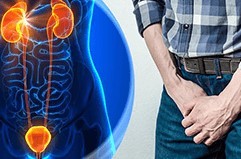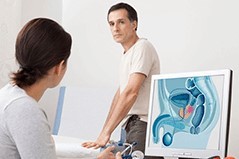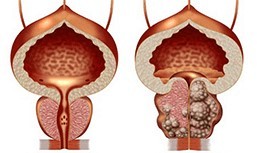Prostatitis - inflammation of the gland of the prostate (prostate), an organism that produces a discharge of fluid that is part of semen. Disease sometimes causes severe pain and problems with potency. Treatment of prostatitis it is reasonable to begin immediately after diagnosis.
Symptoms
Prostatitis typically affects men aged 25 to 50. Pathology is very common. From that suffers between a third and half of all men on the planet. The problem of the many symptoms:

- the man experiences discomfort, pain when urinating;
- the urine is slow, fine stream, and has to squeeze;
- in the evening, and at other times of the day there is often a desire to urinate. You can't shake the feeling that not all urine has left the bladder;
- the urine is turbid, mixed with blood;
- pestering pain in the lower part of the abdomen, back, groin, perineum (between the scrotum and the anus);
- also tormented by the pain and discomfort in the area of testicles, penis;
- ejaculation occurs with the pain;
Often there are symptoms of prostatitis, which is similar to the common cold (slight fever, a fever). Are inherent to the bacterial varieties of the disease (more on this later).
Reasons
Prostatitis often occurs in men who previously suffered from the disease. The problem gives rise to:
- infection of the bladder and the urethra;
- HIV and other diseases that doctors are infected during sexual intercourse;
- a trauma to the pelvis - falling from bicycles, horses;
Causes of prostatitis in men the catheter in the urethra to drain urine from the bladder.
Pathology sometimes appears after the prostate biopsy when the analysis is taken a sample of your fabric. After this procedure, the symptoms of prostatitis in men are rare.
Complications
Because prostatitis can:
- appendix inflamed testicles (epididymitis);
- very decrease the amount of sperm, infertility can result;
- appear abscess (cavity with pus).

Numerous scientific studies do not reveal a direct relationship between prostatitis and prostate cancer.
Types of prostatitis
The prostatitis 5 main types: chronic and acute bacterial, chronic bacterial, asymptomatic.
- Chronic non-bacterial (also known as a chronic syndrome of pain in the pelvic region). The most common (more than 90% of all patients hurts them). The symptoms of prostatitis are unstable, come and go. Pathogens in the body not detected. The diagnosis is made if at least 3 months, a man suffering from pain in the pelvis, discomfort during urination and of the other mentioned symptoms. The exact cause of the disease is unknown, but it probably is says:
- neurological problems (neuropathy);
- the irritation of the prostate, which leads to a poor output of urine from the bladder;
- problems with the muscles of the pelvic floor (dyssynergia);
- atypical, as yet unknown to science, virus, bacteria, etc.
- For acute bacterial. There is a chronic pain syndrome in the pelvic region, permanent problems with urination.
- Acute infectious. The most severe form of the disease. Uncommon. Generated:
- E. coli, Staphylococcus and other bacteria;
- sexually transmitted diseases (chlamydia, gonorrhea);
- by the fungus Candida.
- Chronic and infectious. Pathology may not be evident for several years. The symptoms are similar to acute bacterial type, but they are not so much.
- Asymptomatic. Diagnosed accidentally. The symptoms are absent. The ultrasound shows signs of inflammation, and the blood has a high concentration prostatospecific antigen.

Symptoms increase quickly. Discomfort in the pelvis joins in the pain of the genitals, fever, nausea, burning pain when urinating. Acute bacterial prostatitis can cause serious, life-threatening complications - abscesses, inability to urinate, low blood pressure.
Diagnosis
The diagnosis is made by:
- digital rectal exam;
- analysis of urine. Required to determine if the gland of prostate infection;
- blood. Check the level of the prostatospecific antigen. Test reveals signs of inflammation;
- Ultrasound of the genitourinary system. Is assigned when the above tests for an accurate diagnosis is not enough. Ultrasound of the prostate is preferable to make through the anus (transrectally method).
Also sometimes the doctor examines the prostate secretion. To achieve this, the massage of the gland.
May be assigned analyses in different venerologic infections that are the cause of the inflammation of the prostate.
A professional diagnosis will help to prescribe the correct treatment of prostatitis in men.
Treatment
If the prostatitis is bacterial, a doctor prescribes:
- Antibiotics. Their appearance depends on the identified bacteria. Medication will take a month and a half. If the symptoms are very severe, antibiotics are administered intravenously with urgency.
- Alpha-blockers. Tools relax the muscles of the bladder at the site where it joins the prostate. Eliminate the pain during urination.
- Analgesics - nonsteroidal anti-inflammatory drugs.

It is impossible to prescribe medications independently. Only a doctor determines how to treat the prostatitis.
Prevention
To prevent prostatitis:
- take a warm sitz bath;
- applied to the lower part of the abdomen or back warmer-a pillow;
- stop drinking alcohol, caffeine, foods that increase acidity (spicy, salty);
- consume lot of fluids (without sugar). So we wash the urinary system, the bacteria do not have time to multiply;
- will try for a long time not to ride a bike for a long time not to sit;
- do not forget about the hygiene of the penis, perineum;
- use of contraceptive methods;
- sports. Simple cardio exercises will be enough - to begin to run, swim in the pool, do a light workout.
Prevention of prostatitis should be part of the lifestyle. Simple ways to protect the body.































